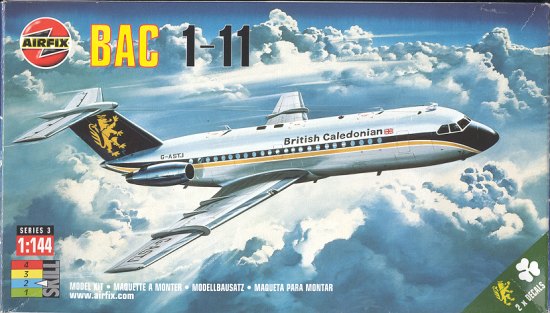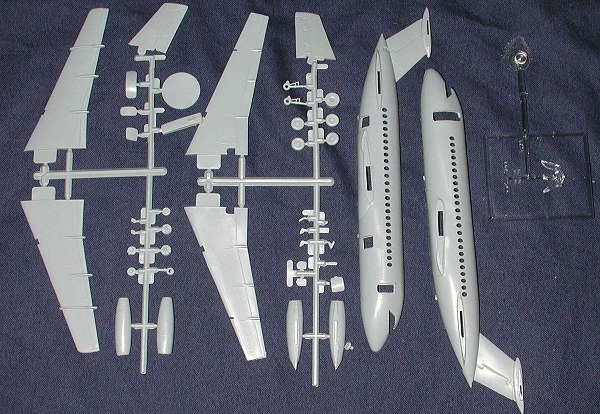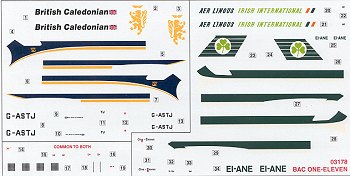
|
KIT: |
Airfix 1/144 BAC 1-11 |
|
KIT # |
3178 |
|
PRICE: |
$9.50 MSRP |
|
DECALS: |
Two liveries |
|
REVIEWER: |
|
|
NOTES: |

|
HISTORY |
The BAC 1-11 story began in the 1950s as Vickers Armstrong and Hunting Aircraft commenced work on two separate design studies for a short haul jet airliner. By 1961 the newly formed British Aircraft Corporation decided to proceed with the project and on the 9 May 1961 the public launch took place as the first order was announced by the company for 10 aircraft from British United Airways. On 23 October Braniff Airways placed a firm order for 6 aircraft. Other orders soon followed from Mohawk Airlines for 4 aircraft, Kuwait Airways for 3 aircraft and by Central African Airways for 2 aircraft. Braniff Airways subsequently doubled it's order to 12 aircraft while Aer Lingus ordered 4 aircraft. Western Airways ordered 10 aircraft but later it was cancelled. The biggest breakthrough came when American Airlines ordered 15 aircraft on the 17 July 1963. 60 orders had been received by the time the first 1-11 was rolled out.
The prototype G-ASHG rolled off the Hurn production line on 28 July 1963 in the livery of first customer British United Airways. The first flight took place on 20 August. Unfortunately this aircraft crashed killing all on board on 22 October. Despite this early setback the flight test program continued and customer confidence remained high. American Airlines and Braniff Airways placed more orders in February 1964. During this year further orders were received from Mohawk Airlines, Philippine Airlines and from Helmut Horten who ordered the first Executive aircraft. By the end of 1964 13 aircraft had rolled off the production line.
After nearly 2 years of flight testing the aircraft was certified and the first 1-11 delivery, G-ASJI to British United Airways, took place on 22 January 1965. After several weeks of route proving flights the first revenue service commenced on 9 April with G-ASJJ from Gatwick to Genoa. Braniff took delivery of their first aircraft N1543 on 11 March while Mohawk Airlines took their first aircraft on 15 May. Deliveries continued to take place and by the end of 1965 34 aircraft had been received by their customers. In fact such was the demand that a second production line was set up at Weybridge to cope. Total deliveries for 1966 stood at 46 aircraft. 1967 to 1971 saw another 120 aircraft delivered with the most significant order going to British European Airways but then the decline set in! In the period 1972 until the production line finally closed in 1982 only another 35 aircraft were built! Even today, there are a rather large number of 1-11s still in passenger operation, mostly in feeder and second or third line operations.
|
THE KIT |

If you are an airliner builder, then I don't have to do much in the way of explanation on this kit as just about all Airfix airliner kits are quite similar. They have raised panel lines, separate cargo and passenger doors, and they have both cockpit and cabin windows. This is a bit of a mixed blessing. It seems to me that airliner builders fall into two major categories. Those that like separate windows and those that like blank fuselages so they can use decals for windows. I'm more of the second category than the first. Unlike some other Airfix kits, this one does not include cabin windows, only a transparency for the cockpit. The deal is that one will apply the cheat line decals and then use a small 'punch' tool that is often included to puncture the decal and open up the window. Then one applies white glue or other similar substance to simulate the windows.
Back to the kit itself. Since new it isn't, It is nice to see that the
molds have held up so well over the years. These are practically flash
free. The parts are also devoid of sink areas and ejector pin marks. Most
of us will be moaning about filling in the seams on the engine pods, but I
know of no aftermarket company that does things like this in resin. It
would be great if someone did single piece resin replacement engine pods
for airliners. This may be a good start up idea if anyone out there is
looking to be an aftermarket entrepreneur! Nose weight wi ll
be needed to keep it on its nose wheels. Naturally, no cockpit is provided
so there is lots of space. Just why the doors are separate is a real poser
to me, but there it is.
ll
be needed to keep it on its nose wheels. Naturally, no cockpit is provided
so there is lots of space. Just why the doors are separate is a real poser
to me, but there it is.
Instructions are the usual Euro-style with instruction drawings only and the usual pathetic color callouts by Humbrol numbers only. Some of them will need to be mixed, if I read my instructions properly. Markings are provided for British Caledonian and Aer Lingus . Cheat lines and the big logos are provided. The decals are semi-matte and look to be well printed. I don't think there will be any real problems using them. There have been aftermarket decals made for this kit, but there are not that many around.
|
CONCLUSIONS |
This kit is a case of "If you want a BAC 1-11, well here it is". It should be relatively easy to build and though Airfix no longer supplies a display stand, airliners look best in flight, so build a nice one for it.
|
REFERENCES |
If you would like your product reviewed fairly and quickly by a site that has over 200,000 visitors a month, please contact me or see other details in the Note to Contributors.